Action sports: combining natural and artifical light
Words and photos by Lars Scharl
If I want to describe my style of shooting then the first thing that comes to my mind is that I really, really love to work with natural light and that I always try to make the best out of the mood and surroundings of a location.
For example, I have to admit that I'm deeply into dawn and dusk light - a beautiful sunrise or sunset is the perfect backdrop for my favorite style of shooting. Of course I'm also happy with dramatic clouds and foggy forests - pretty much everything except mid-day harsh sunlight that robs all the colors and adds very hard contrasts to your shots.
From time to time, I need to illuminate some additional parts of the photo though: since I shoot action sports, that would be the athletes! ;)
What would happen if I didn't use the flashes? Well - if I were at a backlit location, for example with a nice sundown in the background, I'd need to overexpose the backdrop if I wanted to expose the rider in the foreground correctly. If I set everything up for a perfectly exposed backdrop, I'd end up with a very dark main subject in the foreground - luckily, flash usage is a very convenient way to get rid of these kinds of problems :)
Depending on the surroundings, I use either multiple compact flashes like Canon Speedlites or bigger flash guns like the Elinchrom Ranger series. This choice depends on two main factors: distance to the main subject and angle towards the sun. The closer to the rider I can set up my flashes, the less powerful they need to be. If I have to work against the sun though, I'll need a lot of flash power to over-power it. So if the sun is placed directly in the backdrop for example, compact flashes may be too weak to efficiently illuminate the rider and freeze the action.
Why do I use multiple flashes? Using only one flash, for example an on-camera flash, often results in a very "flat" look to the photo. Disconnecting the flash from the camera by using radio transmitters immediately results in much more interesting light - adding further flashes gives you additional opportunities to illuminate the subject as you please. For example when I shoot mountainbiking, I often place one flash behind the rider (as seen from the camera's angle!) so that it puts a nice rim-light on spokes, clothes etc.! In general, multiple flashes give you a lot of freedom setting up the perfect lighting for the specific location you're shooting.
For example, I have to admit that I'm deeply into dawn and dusk light - a beautiful sunrise or sunset is the perfect backdrop for my favorite style of shooting. Of course I'm also happy with dramatic clouds and foggy forests - pretty much everything except mid-day harsh sunlight that robs all the colors and adds very hard contrasts to your shots.
From time to time, I need to illuminate some additional parts of the photo though: since I shoot action sports, that would be the athletes! ;)
What would happen if I didn't use the flashes? Well - if I were at a backlit location, for example with a nice sundown in the background, I'd need to overexpose the backdrop if I wanted to expose the rider in the foreground correctly. If I set everything up for a perfectly exposed backdrop, I'd end up with a very dark main subject in the foreground - luckily, flash usage is a very convenient way to get rid of these kinds of problems :)
Depending on the surroundings, I use either multiple compact flashes like Canon Speedlites or bigger flash guns like the Elinchrom Ranger series. This choice depends on two main factors: distance to the main subject and angle towards the sun. The closer to the rider I can set up my flashes, the less powerful they need to be. If I have to work against the sun though, I'll need a lot of flash power to over-power it. So if the sun is placed directly in the backdrop for example, compact flashes may be too weak to efficiently illuminate the rider and freeze the action.
Why do I use multiple flashes? Using only one flash, for example an on-camera flash, often results in a very "flat" look to the photo. Disconnecting the flash from the camera by using radio transmitters immediately results in much more interesting light - adding further flashes gives you additional opportunities to illuminate the subject as you please. For example when I shoot mountainbiking, I often place one flash behind the rider (as seen from the camera's angle!) so that it puts a nice rim-light on spokes, clothes etc.! In general, multiple flashes give you a lot of freedom setting up the perfect lighting for the specific location you're shooting.
The first picture I want to show you is also one of the very first photos of my career as an action sports photographer - I took it on my very first photo trip, a five-day tour to Southern Italy and the location was close to San Remo. We had spent the whole day looking for scenic photo spots, but as you can see there was thick fog all around and we hadn't really found anything until Falco saw this little bump on the trail. I really liked the surrounding trees and the misty mood, so I decided to include as much of it as possible - which meant I put on my Fisheye and lay down on the trail. I used three flashes to illuminate Falco and told him to pass by me as close as he could. As you can see, he did a very good job and almost hit my head with his left pedal. But nothing happened and we got the shot of the trip on that day.
The photo later went on to win 1st price in Germany's biggest photo competition for young sports photographers and I can definitely say that it was the first big step forward for me!
Rider: Falco Ruppert
Equipment: Canon EOS 1D, Canon 15mm 2,8 Fisheye, 3x Canon 540EZ triggered by Bowens Pulsar radio transmitters
The photo later went on to win 1st price in Germany's biggest photo competition for young sports photographers and I can definitely say that it was the first big step forward for me!
Rider: Falco Ruppert
Equipment: Canon EOS 1D, Canon 15mm 2,8 Fisheye, 3x Canon 540EZ triggered by Bowens Pulsar radio transmitters
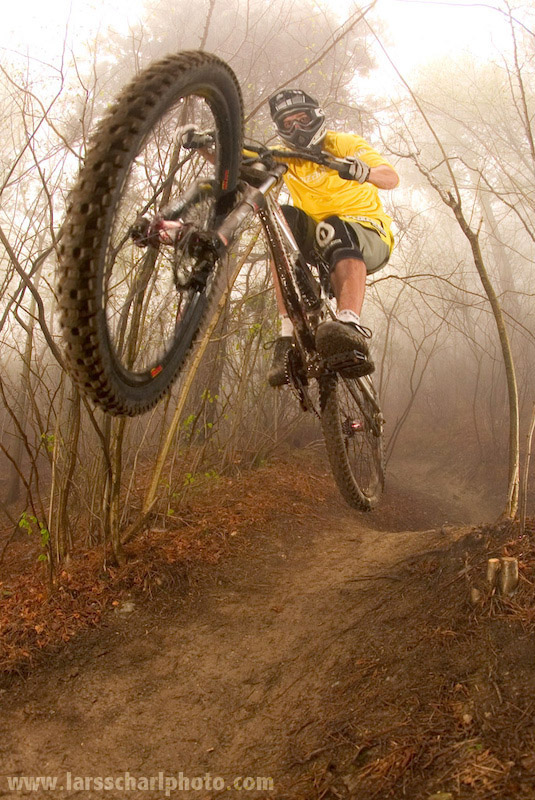
The next example is a shot which I took in february of 2012 - I was in Finland to shoot some snow mountainbiking action with a young Finnish athlete, Antti Rissanen. Despite the nasty conditions - the temperature was below -20° Celsius all day - we spent about three hours at the location and this photo is my favorite from that day. I used three compact Canon 540EZ to illuminate Antti against the evening sky and to have some backlight on the spray that flies off the takeoff ramp. If you watch closely, you can see some motion blur at the rear wheel - this is due to the sun being reflected off the snow and caused me some headache on other shots. Luckily, with Antti's body and most of the bike the main subject is tack-sharp, so the rear wheel adds a little dynamic movement to the shot!
Rider: Antti Rissanen
Equipment: Canon EOS 7D, Zenitar 16mm 2,8 Fisheye, 3x Canon 540EZ triggered by PocketWizard radio transmitters
Rider: Antti Rissanen
Equipment: Canon EOS 7D, Zenitar 16mm 2,8 Fisheye, 3x Canon 540EZ triggered by PocketWizard radio transmitters

Another shot, again with Antti Rissanen: a couple of weeks after the shooting in Finland, we met up in Barcelona to shoot some early-season photos. On the first evening, we decided to look for a street spot along the Mediterranean beach. Shortly after we found this funny spot, the sun went down and illuminated the clouds from below - it seemed as if the city in the background had caught fire! I had decided to use two flashes to the left and right of the frame, to illuminate a horizontal part of the foreground. I had hoped that some pedestrians would walk in the photo and make for a funny detail in the shot, but the dog was even better!! I consider this shot one of my all-time favorites simply because the timing worked so perfectly and the dog adds such a funny detail to the shot - and of course it's also placed perfectly in the flash-lit part of the photo!
Rider: Antti Rissanen
Equipment: Canon EOS 5D Mark2, Canon 70-200 2,8, 2x Canon 540EZ triggered by PocketWizard radio transmitters
Rider: Antti Rissanen
Equipment: Canon EOS 5D Mark2, Canon 70-200 2,8, 2x Canon 540EZ triggered by PocketWizard radio transmitters
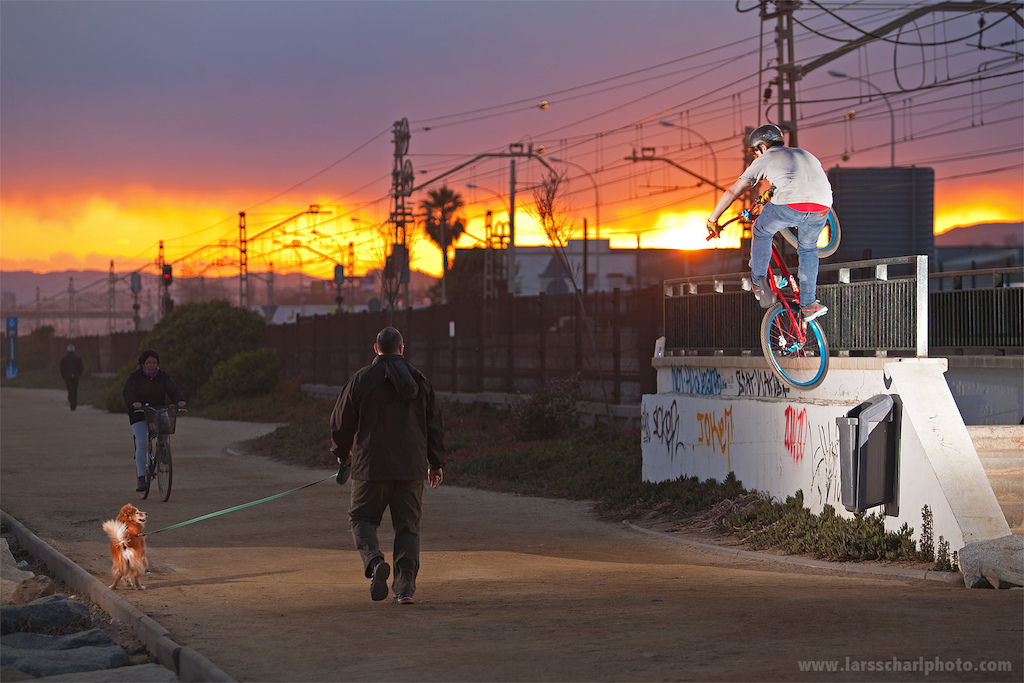
The next photo is a summer shot for which I used a more powerful flash combined with a softbox to have, well, softer light on Julia. Originally we were at that location to shoot portraits and lifestyle shots, but when the sun turned reddish, I couldn't help myself and had to take a couple of action snaps as well :)
Again, setting the camera up for a perfect backdrop exposure and illuminating the athlete with the flash and softbox resulted in a colorful and vivid image.
Rider: Julia Hofmann
Equipment: Canon EOS 7D, Canon 70-200 2,8, Profoto Acute
Again, setting the camera up for a perfect backdrop exposure and illuminating the athlete with the flash and softbox resulted in a colorful and vivid image.
Rider: Julia Hofmann
Equipment: Canon EOS 7D, Canon 70-200 2,8, Profoto Acute
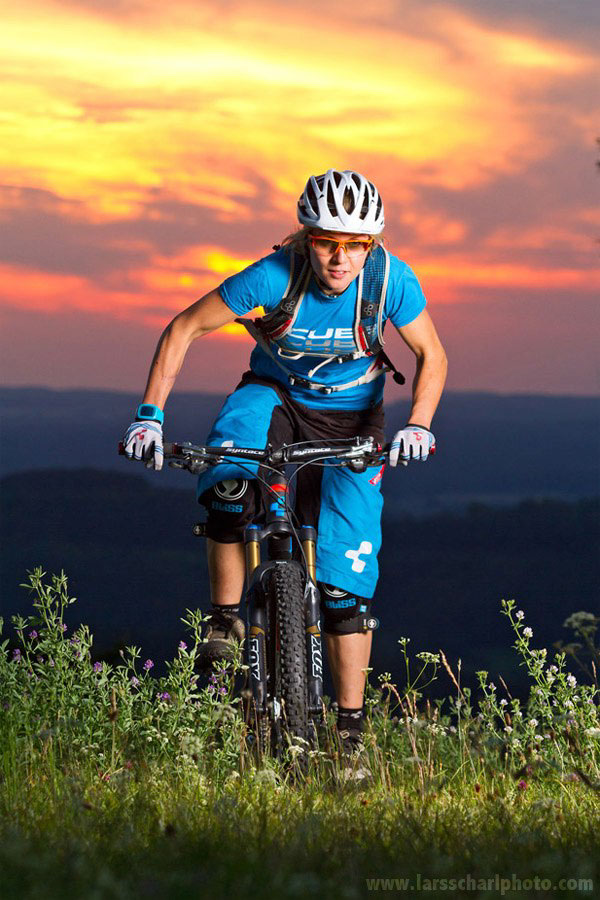
A great upside of using multiple flashes is of course the possibility to illuminate a complex scenery and/or multiple athetes. For the next shot, I used three flashes: one from the left side, which served as the main light for all three riders, one from the right side to put some highlights on the wooden structure and Fischi's rearside. Lastly, I placed one flash on the bottom, to the right of the wooden ladder. This one was turned upwards and served as a rimlight on Fischi's spokes and bike frame.
Riders: Philipp, Dominic (in the berm) and Fischi (airborne)
Equipment: Canon EOS 5D Mark2, 85mm 1,2, 3x Canon 540EZ triggered by PocketWizard radio transmitters
Riders: Philipp, Dominic (in the berm) and Fischi (airborne)
Equipment: Canon EOS 5D Mark2, 85mm 1,2, 3x Canon 540EZ triggered by PocketWizard radio transmitters
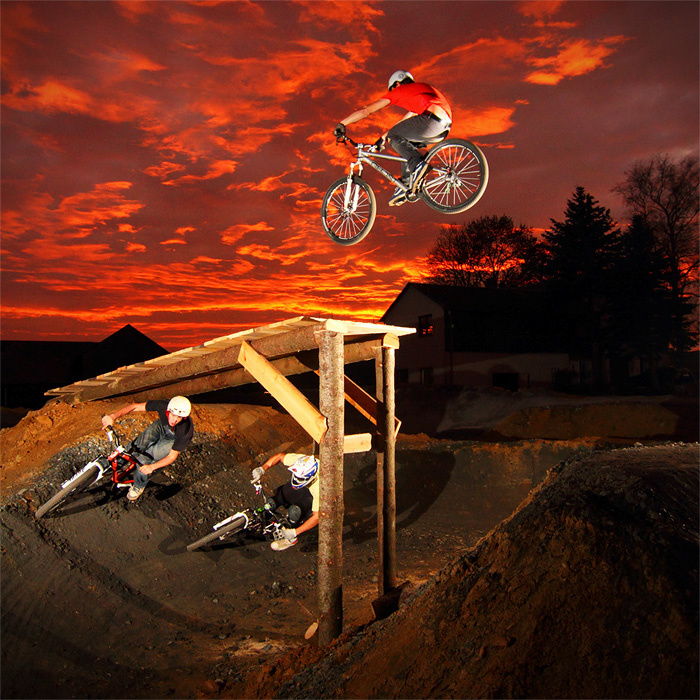
The next photo features Johannes Fischbach again. He is the best downhill mountainbike rider in Germany at the moment and I'm lucky to be able to work with him regularly. In december 2011 I spent a couple of days at his training camp close to Alicante in Spain. We had really bad weather until the second to last day but the forecast was very nice for the last morning. My plane left at 10am., so we made our way up the mountain at 6am. and set up the flashes, hoping that the sunrise wouldn't disappoint us. Luckily, it didn't. I shot the photo at 1/60th of a second using three flashes again. This relatively long exposure time also explains the "ghosting" traces you can see at the rear wheel and Johannes' back for example - these are basically movement shadows where the bike and body moved in front of the sky and so blacked it out before being illuminated in sync with the second curtain of the shutter which froze the action finally.Using longer exposure times in combination with flash also tends to result in nice details of a photo - for example, the front tire as well as the bike logo "GHOST" are partially transparent and still tack sharp and readable.
Rider: Johannes Fischbach
Equipment: Canon EOS 5D Mark2, Zenitar 16mm 2,8 Fisheye, 3x Canon 540EZ triggered by PocketWizard radio transmitters
Rider: Johannes Fischbach
Equipment: Canon EOS 5D Mark2, Zenitar 16mm 2,8 Fisheye, 3x Canon 540EZ triggered by PocketWizard radio transmitters
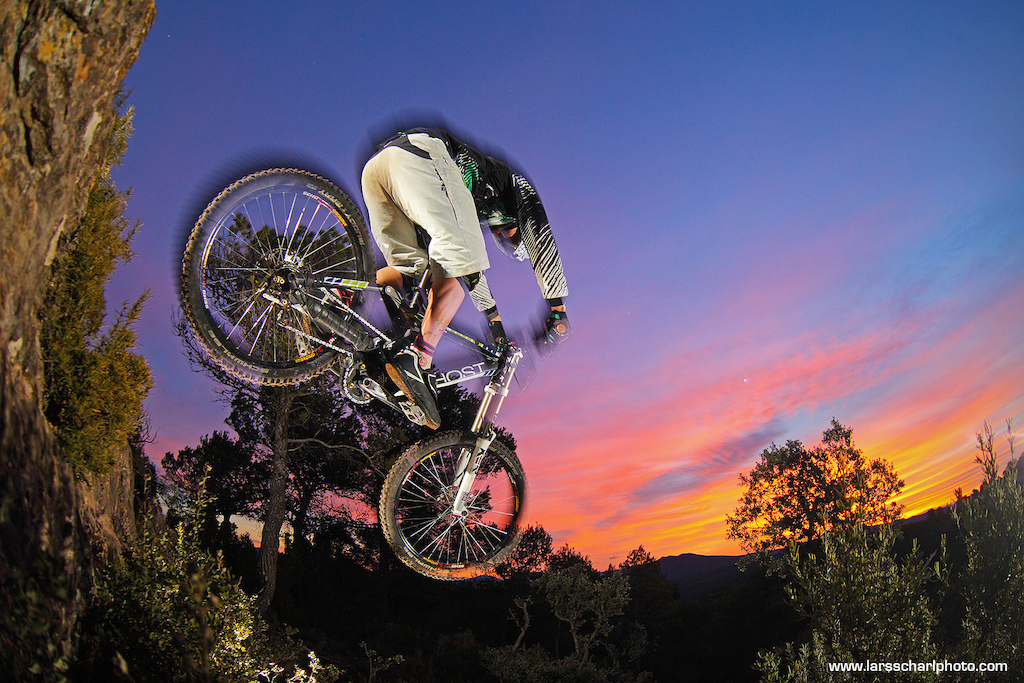
The last flash shot I want to show you is an event photo from Austria - events are quite difficult to shoot, since the light changes constantly and you have to keep flash settings etc. updated all the time. As the distance to the athlete was quite big at this location, I used an Elinchrom Ranger Speed at maximum output - 1200J ! Timo had told me before his run that he wanted to pull a backflip over the big gap jump in the photo - he was the only rider to do so, which is always a good sign because that promises exclusive photo material! Luckily, the sun came out from behind the clouds before it disappeared behind the mountains in the background - and also perfectly in time for Timo's run. He pulled the backflip, I was the only photographer to take a photo of it from this very nice angle and everyone was happy!
Rider: Timo Pritzel
Equipment: Canon EOS 1D Mark2N, Sigma 15-35, Elinchrom Ranger Speed
Rider: Timo Pritzel
Equipment: Canon EOS 1D Mark2N, Sigma 15-35, Elinchrom Ranger Speed

Finally I wanted to show you two examples of natural light usage as well.
For the first shot, I used a Canon 5D with a 70-200 2.8 only - the whole shooting was very fast-paced, because we had only about 30 minutes between arrival at the location and loss of sunlight. My goal that day was to shoot a feel-good autumn ride photo and since Guido is a very experienced photo rider, we quickly had this result - I'm really happy with it because the warm light, Guido's smile and the overall feel of the photo just make you go out and have fun on your bike! (...at least I hope so :) )
Rider: Guido Tschugg
Location: Amerang, Germany
For the first shot, I used a Canon 5D with a 70-200 2.8 only - the whole shooting was very fast-paced, because we had only about 30 minutes between arrival at the location and loss of sunlight. My goal that day was to shoot a feel-good autumn ride photo and since Guido is a very experienced photo rider, we quickly had this result - I'm really happy with it because the warm light, Guido's smile and the overall feel of the photo just make you go out and have fun on your bike! (...at least I hope so :) )
Rider: Guido Tschugg
Location: Amerang, Germany

For the last shot, I experimented with Sunbounce reflectors - and I really got to appreciate them since they help a lot when shooting in mid-day hard contrasts situations.
Rider: Gernot Ruppert
Equipment: Canon EOS 7D, Canon 85mm 1,2, California Sunbounce
Rider: Gernot Ruppert
Equipment: Canon EOS 7D, Canon 85mm 1,2, California Sunbounce
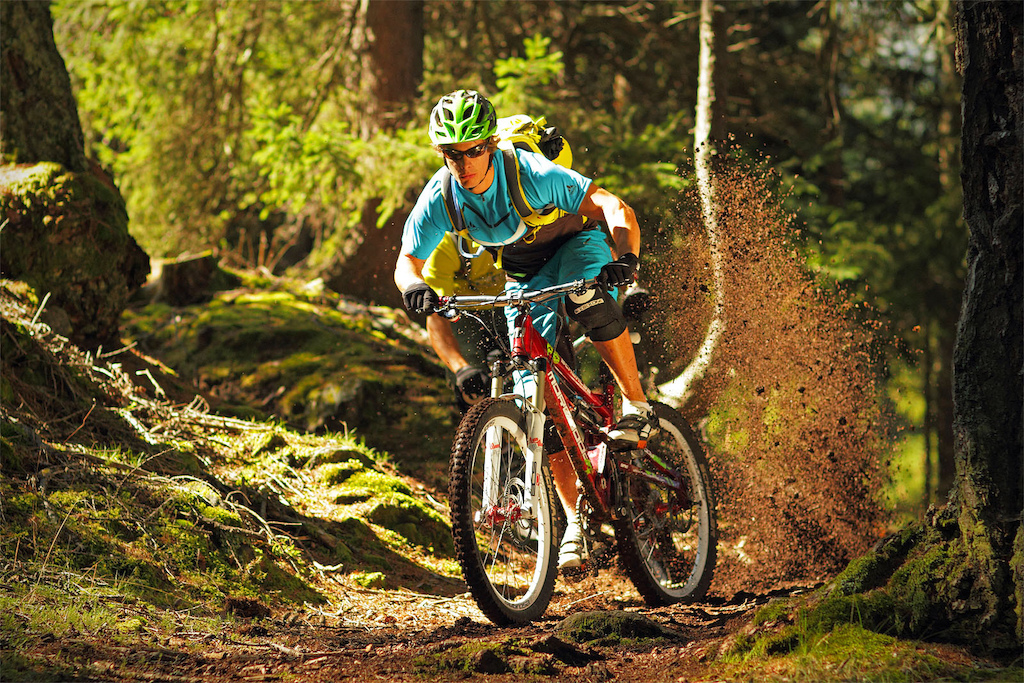
Soooo... I hope you enjoyed this little post about my work!
Feel free to check out more on my website larsscharlphoto.com and also connect on Facebook !
Cheers!
Feel free to check out more on my website larsscharlphoto.com and also connect on Facebook !
Cheers!

